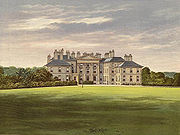

Above, the Duke of Buccleuch's Dalkeith Palace, circa 1880
Above, the Duke of Buccleuch's Dalkeith Palace
| The Duke of Buccleuch |
 |
 |
| Above, the Duke of Buccleuch's Dalkeith Palace, circa 1880 |
Above, the Duke of Buccleuch's Dalkeith Palace |
|
The title of Duke of Buccleuch (pronounced /bəˈklu) was created in the Peerage of Scotland in 1663 for the Duke of Monmouth, who was the eldest illegitimate son of Charles II of Scotland, England, and Ireland and who had married Anne Scott, 4th Countess of Buccleuch. Over time, the family accumulated various titles and subsidiary titles, including: Earl of Buccleuch, Earl of Dalkeith, Lord Scott of Buccleuch, Duke of Monmouth, Earl of Doncaster, Baron Scott of Tindale, Duke of Queensberry, Marquess of Dumfriesshire, Earl of Drumlanrig and Sanquhar (1682), and more. The Dukes of Buccleuch are the hereditary chiefs of Clan Scott and have been the biggest landowners in Midlothian for hundreds of years, and still are. The Dalkeith Palace was built upon the remains of the 12th Century Dalkeith Castle. The Dalkeith Castle has a very rich history in Scotland. The castle was owned at different times in history by King James VI of Scotland (later known as James I, King of England and the son of Mary Queen of Scots), King Charles I, who used the estate as a personal hunting grounds, and General Monk and Cromwell, who planned the Restoration of the Monarchy and King Charles II to the throne in the castle between 1650 – 1654. The palace was visited by Bonnie Prince Charlie on his fateful march south to London during the Jacobite Rebellion. The castle was brought to ruin sometime in the late 17th Century. The Duke of Buccleuch’s wife Anne then ordered the palace to be built, in the same fashion of William of Orange’s palace in the Netherlands. In 1822, Walter Montague-Douglas-Scott, 5th Duke of Buccleuch entertained King George IV at the palace. After the king's visit, the main house entrance was closed and remodeled. Apparently, the king had caught a cold from the draught and improvements were felt necessary. The 5th Duke ordered extensive rebuilding in 1831. Queen Victoria visited the house in 1842. More minor alterations were carried out afterwards, together with improvements to the surrounding estate including the construction of St Mary's Church as a private chapel for the Duke in 1843-45. Dalkeith Palace was used by the Duke's family until 1914 at which time they took up residence at one of their other estates. During World War I, the Dalkeith Estate was used to house soldiers. Dalkeith Palace was used during WWII to house Polish troops as prisoners of war. Currently, the Palace is leased to the University of Wisconsin for a study-abroad program. St. Mary's Church, Dalkeith |
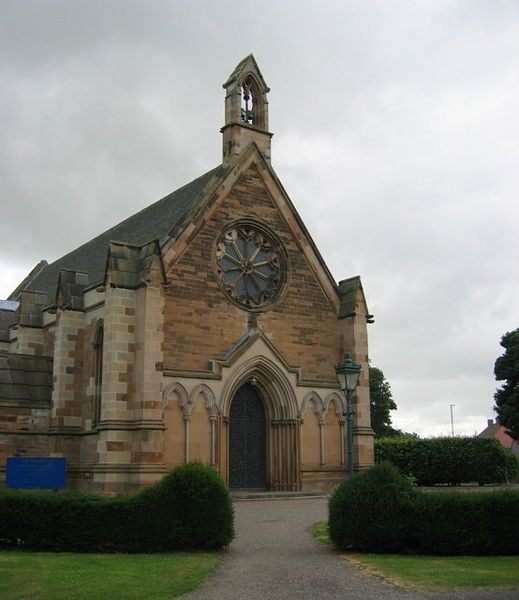 |
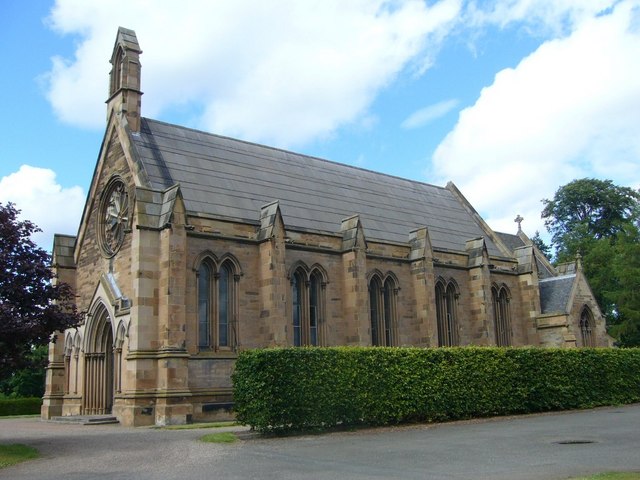 |
|
St Mary's Church, dedicated to St Mary the Virgin, was built in 1843 and consecrated in 1845. It is situated just within the gateway of a ducal park, The church is a fine example of English university chapel style architecture. It is lofty, with an elegant double hammer-beam roof with fan vaulting in the chancel. Worthy of particular note are the windows of the east and west ends. The mosaic glass of the west Wheel (or Rose) window, and the New Testament scenes in Gothic frames in the three east windows, were designed and executed in France in 1845. The church contains one of only two water-power organs in the UK. A tile depicting the crest of Buccleuch decorates the church steps. The church crypt is still the resting place of the remains of some of the family even though the family no longer owns the chapel. So, the Buccleuch family was part of the Scott clan, not the Murray clan. But still, it was a private chapel. How could John Murray Wighton and Amy Louisa Hutcheon swing getting married in it? Further research was certainly warranted. I located the church's website, found an email address for the minister, and got a quick reply to my query from Reverend Peter Harrris, Rector of St. Mary's. The Church was built in 1843 and consecrated in 1845 as a private Chapel for the 5th Duke of Buccleuch. The story is told that the 5th Duke built the church as a gift to his fiancé who was an Anglican. The story as it has been told to me is that she refused to come to Scotland and worship in a Presbyterian Church (the Church of Scotland) so the Duke ordered that an Anglican Chapel be built. So as a love gift for his bride he built St Mary's as a place of Anglican (Episcopal) Worship based on the English (Cambridge/Oxford) University Chapel style architecture. Ironically the Duchess for some reason soon after arriving in Dalkeith converted to Rome Catholicism and therefore never used the Church as her place of regular worship. (Grounds for divorce if you ask me!) The church however was used by the Duke's family and the estate workers. Local Episcopalians were welcomed to worship in the chapel. The Dukes of Buccleuch maintained a Chaplain or Priest at the Church until 1915. In 1915 the 7th Duke handed over the running of the Chapel and provision of Priest to the Diocese of Edinburgh, while still retaining the rights of ownership. In 1958 the church Congregation became properly constituted as caretakers of the Church with the Duke of Buccleuch acting as a trustee. Throughout this time St Mary's developed an excellent Choir School which gained favourable reputation and was locally known as the Duke's Canaries. Sadly the Canaries are no more. Intriguingly the Chapel has a water powered Organ which still accompanies worship today. We only know of two other water powered organs in the UK. There are a few reasons why your Great Grandparents may have been able to get married in St Mary's:
Guess that rules out the friendly relationship with the Duke of Buccleuch theory. Oh well. |
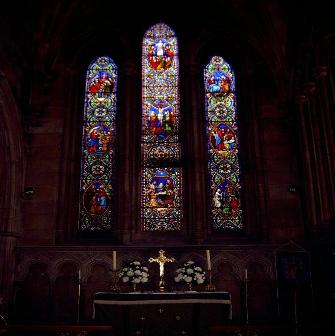 |
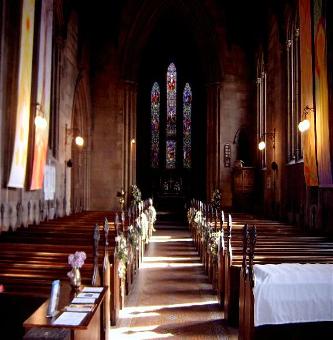 |
| Above, St. Mary's Church interior |
Above, St. Mary's Church interior |
|
Sources E-mail February 8, 2010 from Reverend Peter Harris, Rector of St. Mary's, revpharris@googlemail.com Various web sites, including: Dalkeith Estate: http://uwrf.edu/wis/pdf/dalkeith_estate.pdf Dalkeith Palace: http://en.wikipedia.org/wiki/Dalkeith_Palace Dalkeith Palace: http://brittinbritain.wordpress.com/2008/08/02/the-dalkeith-palace/ Duke of Buccleuch: http://en.wikipedia.org/wiki/Duke_of_Buccleuch The History of St. Mary's: http://www.stmarysdalkeith.co.uk/4.html The first image of St. Mary's Church was taken by Richard Webb. http://commons.wikimedia.org/wiki/File:St_Mary%27s_Church_Dalkeith_-_geograph.org.uk_-_28731.jpg The second image of St. Mary's Church was taken by Kim Traynor. http://www.geograph.org.uk/photo/1417491 |